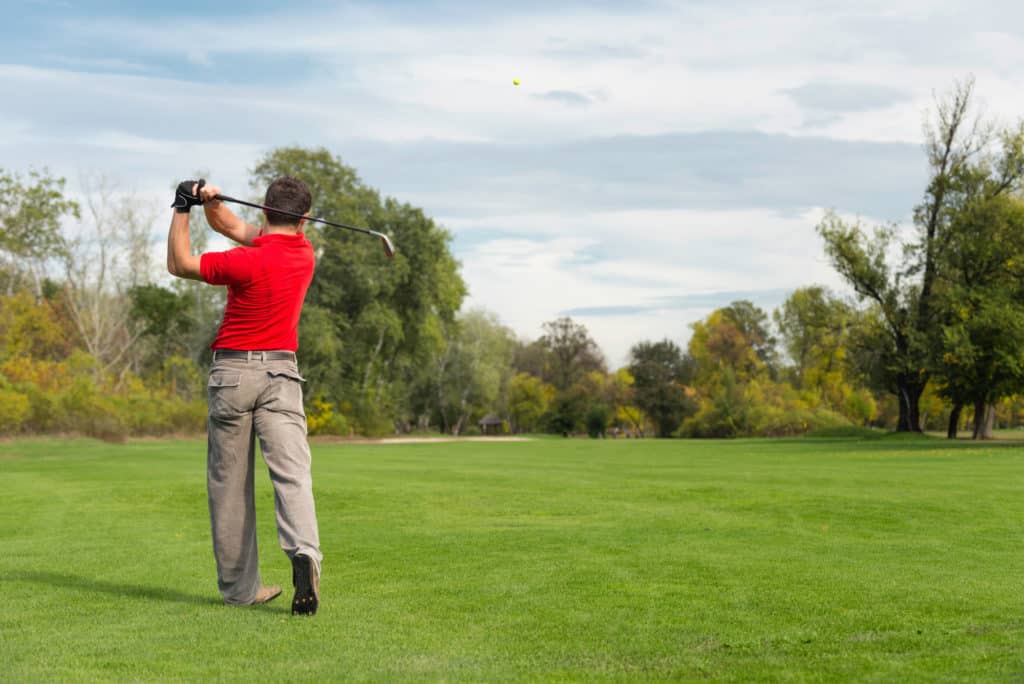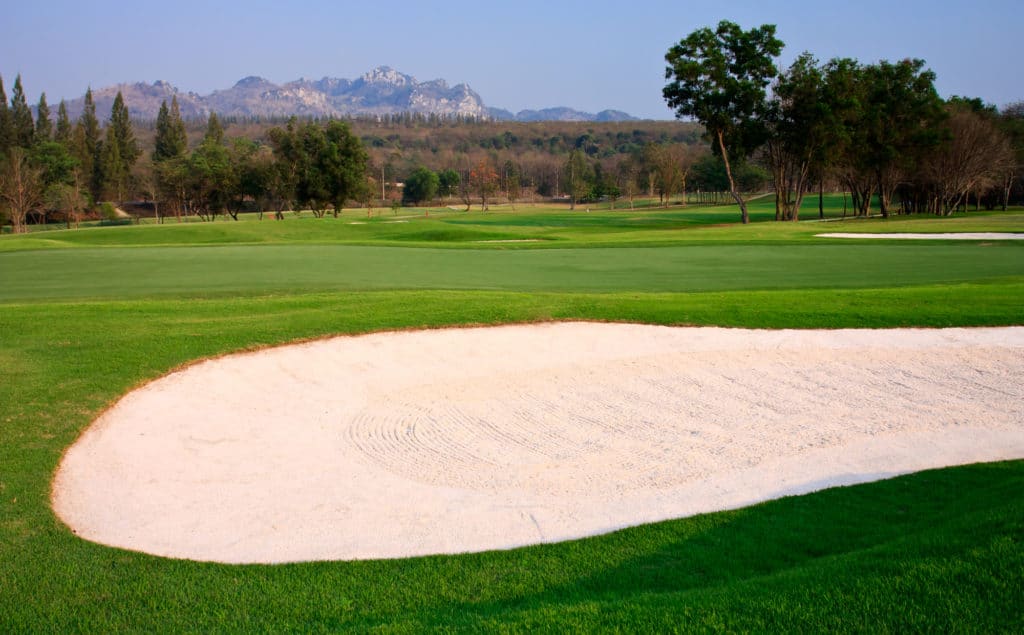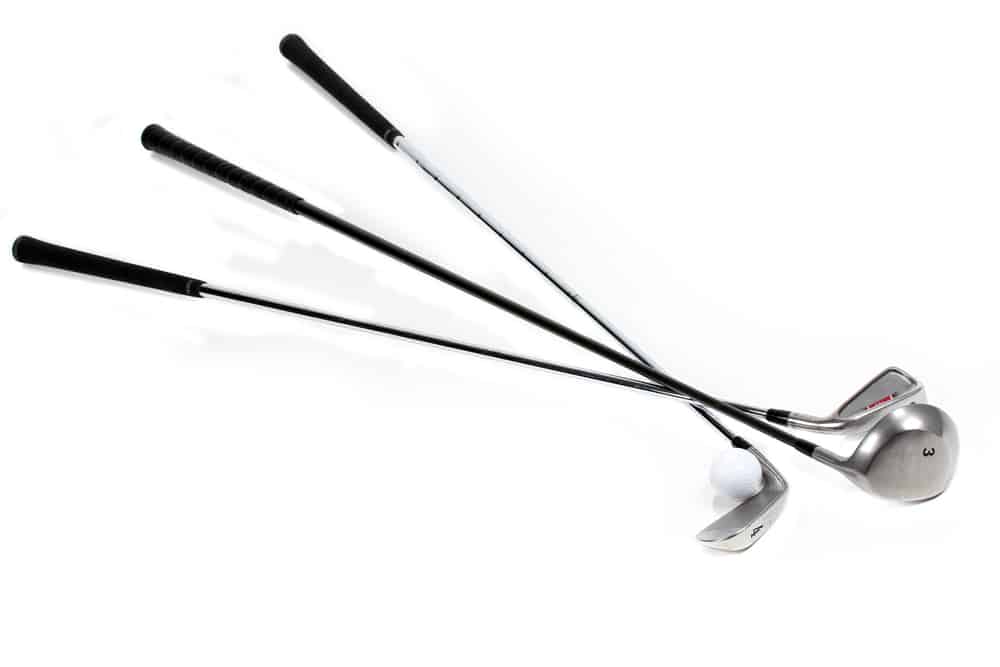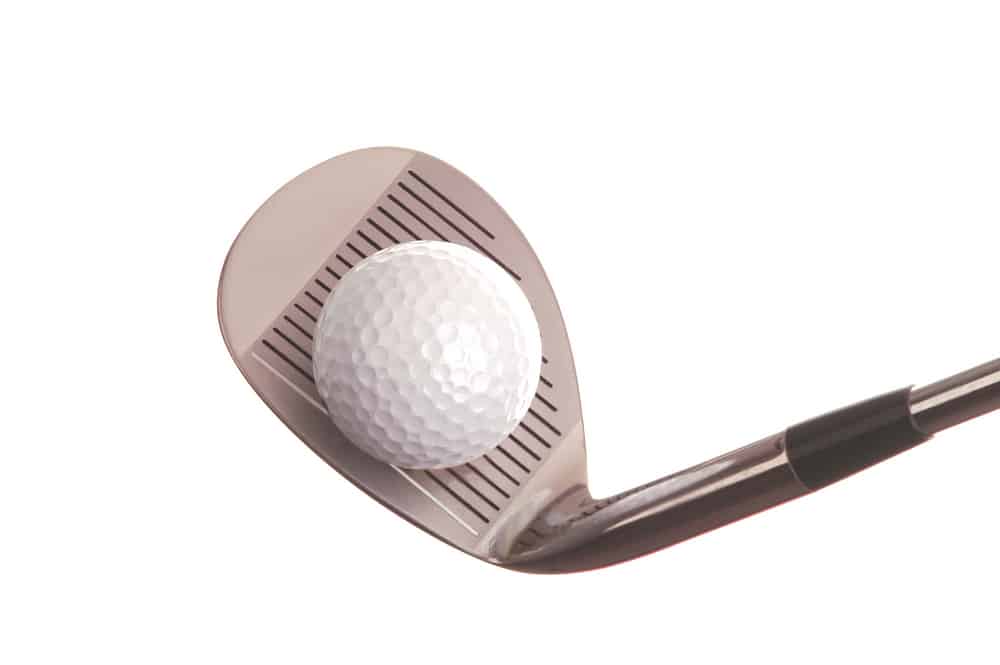
A 60-degree wedge is a great tool to keep in your bag.
You can use it for a variety of shots around the green and out of the bunker.
Some people will also use their 60-degree wedge for full swing shots.
This leaves many people asking about how far a 60-degree wedge will go.
In this guide, we will help you answer that question and give you some insight into how and when to use that 60-degree wedge.
How Far Should You Hit a 60 Degree Wedge?

How far you hit your 60-degree wedge will depend on what type of a golfer you are.
If you are a professional, you will hit your wedge a bit further than an amateur golfer.
On average, a professional golfer will hit a 60-degree wedge about 100 yards.
A mid-handicap golfer will probably hit their 60-degree wedge about 50-60 yards.
A higher handicap golfer will probably hit their 60-degree wedge about 30-40 yards.
Even though a 60-degree wedge can travel these distances, you may or may not want to take a full swing and hit is quite this far.
When Should You Use a 60 Degree Wedge?

Using a 60-degree wedge around the green is very common; however, there are some other uses for this golf club.
Here are the times that it is best suited to use your 60-degree wedge.
Full Swing
Experiment with your 60-degree on the driving range and see how far you can hit it.
Since certain 60-degree wedges have different levels of bounce and grind, some are better for long shots than others.
On average, you will probably be able to hit your 60-degree anywhere from 50-75 yards.
The problem sometimes is that if you miss the 60-degree wedge just a little, it could end up going over the green.
Certainly, there is a risk with any club you swing, but the 60-degree is known for being easy to blade across a green.
In general, they are not the most forgiving golf club when it comes to full swing shots.
Most are a blade-type design and have no cavity back.
Chipping
If you find that your approach shot has just missed the green, you may need to chip.
Chipping with a 60-degree wedge can be a great choice because of its loft and spin.
When you miss on the side of the green where the pin is, and there is not much green to work with, this is called short siding yourself.
When you are short-sided, you need a shot that gets up and down and stops quickly.
The 60-degree is perfect for this.
It can get a good amount of spin and launch even out of a lie that is a little rough.
Flop Shots
A flop shot is a very high lofted shot that does not fly a far distance, but it travels very high.
Flop shots became very popular with the help of Phil Mickelson.
This is a shot that he loves to hit.
In addition to using the 60-degree wedge, many people open the blade of the wedge to get even more loft and launch.
A flop shot is different than a chip because it requires a very large swing and then sliding the club beneath the ball.
This is not a percentage shot.
You will not want to hit a flop shot around every green, but it can be an excellent tool in certain situations.
Sand Shots
Many golfers will go directly to their sand wedge of 56-degree wedge every time they walk into a bunker.
This is not always the best club choice.
Having a club, you are comfortable with when in a bunker is a big part of whether or not you will be successful.
The 60-degree wedge has four more degrees of loft than a traditional sand wedge.
This helps to get the ball out over the lip of the bunker, and it also can help it stop sooner on the green.
If the bunker you are in is one of those that you can barely see out of, you should be using the club with the most loft available.
The more people try their 60-degree out of those smaller greenside bunkers, the more it becomes the go-to club.
When you have a 20-yard bunker, shot the 60-degree might get up and down too quickly, and you will end up being better off using your 56-degree.
Get Out Of Trouble
If you are playing a golf course with very thick rough, you may find at times that you get entirely buried in the rough.
The 60-degree wedge is very good at cutting through this rough.
With the extra loft and the fact that 60-degree wedges are a little heavier, you can pop the ball right out of the rough.
When doing this, you will have to consider this a troubleshot and sacrifice your score a little.
Use the 60-degree to hit a small shot that gets you back into play.
Once you are in play, focus on getting on the green and making one putt.
Tips For Using A 60 Degree Wedge

Now that you see all the times during a round of golf that you can use a 60-degree, you are probably considering implementing it into your game a little bit more.
There are a few things to be aware of before you start doing this.
Here are some tips to start using a 60-degree wedge.
Try On The Range First
Your 60-degree wedge performs a little differently than other clubs.
It would help if you spent a little time on the driving range practicing with this club before you move to the course.
You will need to hit down and through the ball to get the proper spin and control of the 60-degree.
You don’t want to hit this club on the upswing or try and pick it clean.
Check Bounce
A 60-degree can come in a variety of bounce options.
Something with low bounce would be around 4-8 degrees of bounce.
Mid bounce is anywhere from 8-10, and then high bounce would be 12 and up.
Most 60-degree wedges are going to have a higher bounce.
The higher bounce helps them cut through things like rough while still producing spin on the ball.
The higher bounce does not help when it comes to hitting full swing shots off the fairway.
If you don’t know what your bounce is on the 60-degree that you have in your golf bag, you should take a look.
Knowing and understanding the bounce and how to use it can affect how you hit shots around the green.
Stance and Setup
When using a 60-degree wedge, you will most likely be taking an abbreviated swing.
Since you will be taking an abbreviated swing, you should make sure that your setup and stance match this type of shot.
Taking your regular width stance is very likely not necessary.
If you narrow your stance and place the ball towards the middle back of your stance, you will be in a great position to strike the 60-degree accurately.
Remember, we mentioned that this is a golf club that you are going to want to hit down and through with.
If you try and pick it clean, you could end up blading it across the green.
Accelerate
The most common problem with a 60-degree that golfers will face is they slow their swing down as they come into impact.
This is mostly something people do because they are afraid of a bad shot, but sadly it is precisely what causes a bad shot.
When using a 60-degree, you must swing with some speed through the ball and not be afraid to take a little bit of dirt.
Only then can the club perform as it should and give you the results you need.
Should All Golfers Carry A 60-Degree Wedge In Your Bag?

A 60-degree wedge is a very valuable tool to keep in your golf bag.
If you are only carrying 13 clubs and have the room to add another wedge, it does make sense to add one.
A 60-degree wedge is considered a lob wedge.
There are lob wedges sold as a 58 or 62 and sometimes even a 64.
These are all going to be just as beneficial as the 60-degree and will be capable of the same types of shots.
The most important thing to watch out for is the gaps between your wedges.
You want to make sure that if you decide to put a 60-degree in your bag, you don’t already have a 58-degree wedge.
The difference between these two will not be enough to get you that much difference in the results that they produce.
Conclusion
A 60-degree wedge will go anywhere from 40 yards to 100 yards with a full swing.
The distances that you get will be based on your handicap level and what type of 60-degree wedge you have.



Leave a Reply